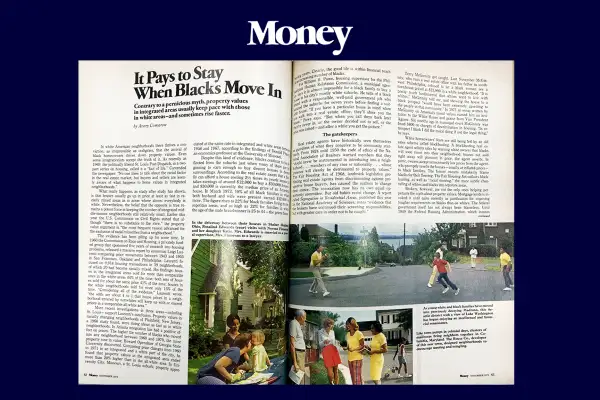Money Classic: Busting a 'Pernicious Myth' About Race and Housing (1973)

Money is turning 50! To celebrate, we’ve combed through decades of our print magazines to uncover hidden gems, fascinating stories and vintage personal finance tips that have (surprisingly) withstood the test of time. Throughout 2022, we’ll be sharing our favorite finds in Money Classic, a special limited-edition newsletter that goes out twice a month.
This excerpt, featured in the seventh issue of Money Classic, comes from a story in our November 1973 edition.
Editor's note: This story includes language that isn't inclusive. Preferred language is always evolving, and Money is committed to writing stories that do not discriminate on the basis of race, color, sex (including gender identity and sexual orientation), religion, age or disability.
In white American neighborhoods there thrives a conviction, as irrepressible as crabgrass, that the arrival of black homeowners drives down property values. Even as some integrationists accept the truth of it. As recently as 1969, the politically liberal St. Louis Post-Dispatch, in a two-part series on housing, called it a "fact of life." Contended the newspaper: "No one likes to talk about the racial factor in the real estate market, but buyers and sellers are keenly aware of what happens to home values in integrated neighborhoods."
What really happens, as study after study has shown, is that houses usually go up in price at least as fast in racially mixed areas as in areas where almost everybody is white. Nevertheless, the belief that the opposite is true remains a potent force in keeping the number of integrated middle-income neighborhoods still relatively small. Earlier this year the U.S. Commission on Civil Rights stated that although "there is no substance to the view," the property value argument is "the most frequent reason advanced for the exclusion of racial minorities from a neighborhood."
The evidence has been piling up for some time. In 1960 the Commission on Race and Housing, a privately funded group that sponsored five years of research into housing problems, released a massive report by economist Luigi Laurenti comparing price movements between 1943 and 1955 in San Francisco, Oakland and Philadelphia. Laurenti focused on 9,914 housing transactions in 39 neighborhoods, of which 20 had become racially mixed. His findings: houses in the integrated areas sold for more than comparable ones in the white areas 44% of the time; both sets of houses sold for about the same price 41% of the time; houses in the white neighborhoods sold for more only 15% of the time. "Considering all of the evidence," Laurenti wrote, "the odds are about 4 to 1 that house prices in a neighborhood entered by nonwhites will keep up with or exceed prices in a comparable all-white area."
More recent investigations in three areas — including St. Louis — support Laurenti's conclusion. Property values in racially changing neighborhoods of Plainfield, New Jersey, a 1968 study found, were rising about as fast as in white neighborhoods. In Atlanta integration has had a positive effect on prices. The higher the number of blacks who moved into any neighborhood between 1960 and 1970, the more property rose in value, Howard Openshaw of Georgia State University discovered. Comparing price changes from 1960 to 1971 in an integrated and a white part of the city, he found that property values in the integrated area ended more than 20% higher than in the all-white area. In University City, Missouri, a St. Louis suburb, property appreciated at the same rate in integrated and white areas between 1958 and 1967, according to the findings of Donald Phares, an economics professor at the University of Missouri.
Despite this kind of evidence, blacks continued to be deflected from the suburbs just when many of them are beginning to earn enough to buy decent houses in decent surroundings. According to the real estate axiom that a family can afford a house costing 2 1/2 times its yearly income, it takes earnings of around $12,000 to buy a $30,000 house — and $30,000 is currently the median price of an American house. In March 1972, 19% of all black families in which both husband and wife were present earned $12,000 or more. The figure rises to 22% for black families living in metropolitan areas, and as high as 32% for families in which the age of the male breadwinner is 25 to 44 — the prime housebuying years. Clearly, the good life is within financial reach of an increasing number of blacks.
Yet William H. Powe, housing supervisor for the Philadelphia Human Relations Commission, a municipal agency, says it is almost impossible for a black family to buy a house in his city's mostly white suburbs. He tells of a black friend with a responsible, well-paid government job who scoured the suburbs for seven years before findings a suitable house. "If you have a particular house in mind when you walk into a real estate office, they'll show you the house," Powe says. "But when you call them back later they're never in, or the owner decided not to sell, or the price was raised — after a while you get the picture."
Subscribe to Money Classic.

